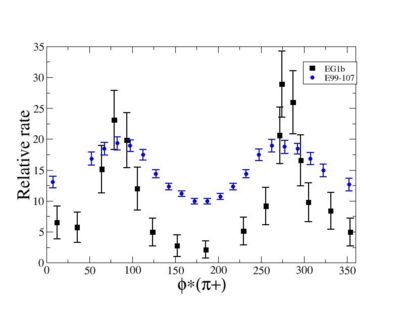Difference between revisions of "PhD Proposal Tamar"
| Line 15: | Line 15: | ||
==Experimental Setup== | ==Experimental Setup== | ||
Tamuna will finish this section by Friday July 31, 2009 | Tamuna will finish this section by Friday July 31, 2009 | ||
| + | |||
| + | ===Target=== | ||
The EG1 experiment at Jefferson Lab used five different targets during their polarized structure function measurement program. The polarized NH3 and ND3 targets were designed and built by collaboration of the Italian Istituto di Fisica Nucleare, TJNAF, Oxford instruments and the University of Virginia. The solid targets(NH3 and ND3) were polarized using the method of Dynamic Nuclear Polarization [[Prok Thesis]]. A 5 Tesla magnet establish the hyperfine splittings needed to polarize the target material using X Ghz RF waves. The polarization was monitored by pickup coils around the target using standard NMR techniques. Three other targets, C12, liquid He4 and frozen N15 were used to employ several methods for removing the Nitrogen contributions to the measured structure functions made using NH3 and ND3. | The EG1 experiment at Jefferson Lab used five different targets during their polarized structure function measurement program. The polarized NH3 and ND3 targets were designed and built by collaboration of the Italian Istituto di Fisica Nucleare, TJNAF, Oxford instruments and the University of Virginia. The solid targets(NH3 and ND3) were polarized using the method of Dynamic Nuclear Polarization [[Prok Thesis]]. A 5 Tesla magnet establish the hyperfine splittings needed to polarize the target material using X Ghz RF waves. The polarization was monitored by pickup coils around the target using standard NMR techniques. Three other targets, C12, liquid He4 and frozen N15 were used to employ several methods for removing the Nitrogen contributions to the measured structure functions made using NH3 and ND3. | ||
| + | |||
| + | The target materials used during the EG1b experiment were frozen ammonia, <math>15NH_3</math> for the polarized protons and <math>15ND_3</math> for the polarized deuterons. Ammonia targets were selected because of their ability to produce high polarization and they are less effected by beam radiation. On the other hand, the damage caused by this radiation can be repair by annealing(heating process). In addition, ammonia target has a high ratio of free nucleons (~3/18) approximately 16.5 % for <math>15NH_3</math> and 26.6 % for <math>15ND_3</math>. One disadvantage of choosing ammonia is the polarization background caused by 15N(spin - 1/2), or 14N(spin - 1). However, for 15N the polarization can be measured easily then for 14N. Also, it does not have any free nucleons, while 14N has one free neutron. That concludes, in case of using 15N ammonia rather than 14N the spin asymmetry measurement should have a smaller correction and error.['''SChen_FSU_thesis'''] | ||
| + | |||
[[CLAS_apparatus]] | [[CLAS_apparatus]] | ||
Revision as of 19:01, 10 August 2009
Tamar PhD Proposal
Abstract
Introduction
Physics Motivation
Tamuna will have a rough draft of this by Friday July 31,2009.
In semi-inclusive scattering experiment, where the scattered electron and one or more hadrons in coincidence are detected, provides a powerful tool for an understanding the structure of nucleons.
Experimental Setup
Tamuna will finish this section by Friday July 31, 2009
Target
The EG1 experiment at Jefferson Lab used five different targets during their polarized structure function measurement program. The polarized NH3 and ND3 targets were designed and built by collaboration of the Italian Istituto di Fisica Nucleare, TJNAF, Oxford instruments and the University of Virginia. The solid targets(NH3 and ND3) were polarized using the method of Dynamic Nuclear Polarization Prok Thesis. A 5 Tesla magnet establish the hyperfine splittings needed to polarize the target material using X Ghz RF waves. The polarization was monitored by pickup coils around the target using standard NMR techniques. Three other targets, C12, liquid He4 and frozen N15 were used to employ several methods for removing the Nitrogen contributions to the measured structure functions made using NH3 and ND3.
The target materials used during the EG1b experiment were frozen ammonia, for the polarized protons and for the polarized deuterons. Ammonia targets were selected because of their ability to produce high polarization and they are less effected by beam radiation. On the other hand, the damage caused by this radiation can be repair by annealing(heating process). In addition, ammonia target has a high ratio of free nucleons (~3/18) approximately 16.5 % for and 26.6 % for . One disadvantage of choosing ammonia is the polarization background caused by 15N(spin - 1/2), or 14N(spin - 1). However, for 15N the polarization can be measured easily then for 14N. Also, it does not have any free nucleons, while 14N has one free neutron. That concludes, in case of using 15N ammonia rather than 14N the spin asymmetry measurement should have a smaller correction and error.[SChen_FSU_thesis]
